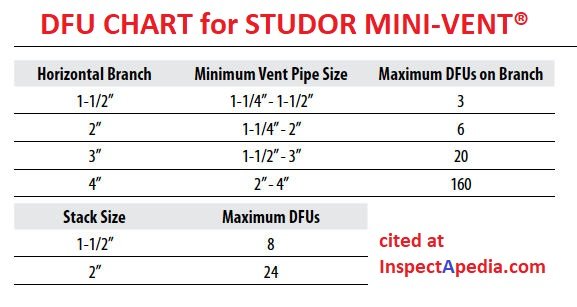A DFU in plumbing stands for Drainage Fixture Unit. It plays a crucial role in determining the drainage load for various fixtures in a building. Understanding what is a DFU in plumbing is essential for proper plumbing design and sizing of drainage systems. The number of DFUs assigned to a fixture depends on its type and size, helping to calculate the total drainage requirements accurately. Properly allocating DFUs ensures efficient and effective drainage in any plumbing system. Now, let’s delve deeper into the significance and function of DFUs in plumbing practices.
Understanding DFU in Plumbing: Everything You Need to Know
Welcome to our comprehensive guide on DFU in plumbing! If you’ve ever heard the term “DFU” thrown around in conversations about plumbing or building codes and found yourself scratching your head, you’re not alone. In this article, we’re going to delve into what exactly a DFU is, why it’s important in the world of plumbing, and how it influences the design and functionality of plumbing systems. So, let’s jump right in!
What Does DFU Stand For?
DFU stands for Drainage Fixture Unit. It is a unit of measure used in plumbing engineering to determine the relative drainage load of different types of fixtures in a building. In simpler terms, DFU helps plumbing professionals and engineers understand how much drainage a particular fixture contributes to the overall plumbing system.
Why Are DFUs Important in Plumbing?
When designing a plumbing system for a building, it is crucial to ensure that the system can handle the expected flow of wastewater and prevent backups or overflows. This is where DFUs come into play. By assigning a DFU value to each fixture, plumbers can calculate the total drainage load on the system and design it accordingly.
The Basics of DFU Calculation
Calculating DFUs involves looking at various factors such as the type of fixture, its size, the anticipated flow rate, and the number of fixtures connected to a drainage pipe. Each type of fixture is assigned a specific DFU value based on its drainage characteristics. For example, a toilet typically has a higher DFU value than a sink due to the larger volume of waste it can handle.
By adding up the DFU values of all the fixtures in a building, plumbers can determine the total drainage load on the system and size the pipes, vents, and traps accordingly to ensure proper drainage and prevent blockages.
How Do DFUs Impact Plumbing System Design?
DFUs play a crucial role in determining the size and layout of a plumbing system. By accurately calculating the DFUs for all fixtures in a building, plumbers can ensure that the system is designed to handle the expected flow of wastewater without issues. This includes sizing the main drainage lines, vent pipes, and traps to prevent clogs and backups.
Ensuring Proper Ventilation
In addition to sizing the drainage pipes, DFUs also help in determining the appropriate size and placement of vent pipes in a plumbing system. Proper ventilation is essential to prevent sewer gases from building up in the pipes and entering the living spaces of a building. By considering the DFUs of fixtures when designing venting systems, plumbers can ensure adequate ventilation throughout the plumbing system.
Meeting Building Code Requirements
Building codes often specify the minimum number of DFUs allowed per fixture type in a building to ensure compliance with plumbing standards and regulations. By understanding DFUs and how they influence plumbing system design, plumbers can ensure that their work meets these requirements and passes inspections.
In conclusion, DFU in plumbing is a fundamental concept that plays a vital role in the design and functionality of plumbing systems. By assigning DFU values to fixtures, plumbers can accurately calculate the drainage load on a system and design it to prevent issues such as blockages and overflows. Understanding DFUs is essential for any plumbing professional looking to create efficient and code-compliant plumbing systems. We hope this article has shed light on the importance of DFUs in plumbing and helped you grasp the basics of this essential concept!
Thank you for reading!
Understanding WSFU and DFU
Frequently Asked Questions
What is a DFU in plumbing?
A Drainage Fixture Unit (DFU) is a unit of measure used in plumbing to quantify the drainage load that different fixtures place on a drainage system. It helps in sizing pipes and estimating the capacity needed for proper drainage.
How are DFUs used in plumbing design?
DFUs are used by plumbers and engineers to calculate the total load on a drainage system based on the number and types of fixtures in a building. This helps in determining the pipe sizes, venting requirements, and overall efficiency of the plumbing system.
Why is it important to understand DFUs in plumbing installations?
Understanding DFUs is crucial in ensuring that the plumbing system functions effectively and efficiently. By accurately calculating the DFUs for fixtures, plumbers can design and install drainage systems that prevent clogs, backups, and other plumbing issues.
Can the number of DFUs impact the performance of a plumbing system?
Yes, the number of DFUs directly affects the performance of a plumbing system. If the total DFUs exceed the capacity of the pipes or vents, it can lead to slow drainage, backups, or even system failure. Properly managing DFUs is essential for a well-functioning plumbing system.
Final Thoughts
A DFU in plumbing stands for Drainage Fixture Unit, which is a unit of measure that quantifies the drainage load produced by various plumbing fixtures. Understanding DFU is crucial for designing efficient and effective plumbing systems. It helps plumbers ensure proper sizing, venting, and drainage for the entire system. In conclusion, grasping the concept of what a DFU is in plumbing is essential for ensuring the smooth functioning of drainage systems.




